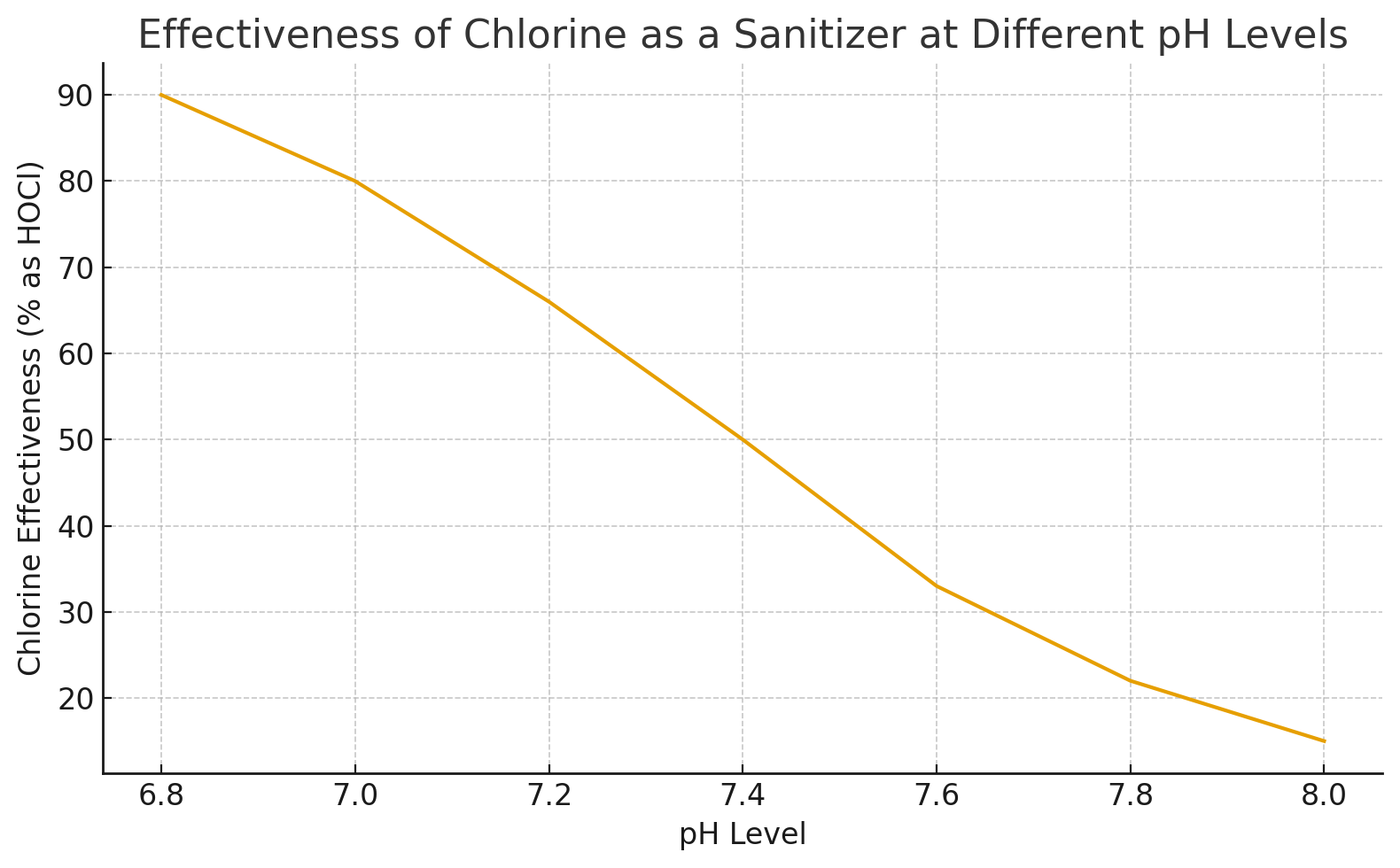How to Fix High pH in a Pool (Quickly and Safely)
Why High pH Is a Serious Problem
High pH is one of the most common—and most frustrating—pool chemistry issues. When pH rises above 7.8, chlorine becomes far less effective (See graph below), algae grows more easily, water becomes cloudy, and swimmers may experience itchy skin or burning eyes.
Left untreated, high pH can also cause scale buildup on heaters, salt cells, and pool surfaces. The good news? Lowering pH is quick and easy with the right approach. This guide shows you exactly how to fix high pH fast, how to prevent it from happening again, and when to bring your water in for professional testing.

prevent pool algae, stop algae in pool, pool algae prevent
Step 1: Test the Water to Confirm High pH
Before adjusting anything, verify the pH level.
Ideal Range:
-
7.1–7.7 for most pools
If your pH is 7.8 or higher, it needs to be lowered.
Test using:
-
Liquid reagent test kits
-
Test strips
-
Digital testers
-
Or bring a sample to Mock Pools & Ponds for free computerized analysis
Knowing the exact pH reading helps you add the right amount of reducer.
Step 2: Add a pH Reducer (The Correct Product)
To lower pH safely, use a pool-grade pH decreaser, such as:
-
Splash pH Minus
-
Muriatic acid (liquid acid)
Do NOT use vinegar, baking soda, or household chemicals. They don’t work properly and can cause more issues.
How to Add pH Reducer:
-
Turn on your pump for full circulation.
-
Pre-dissolve dry acid if recommended by the manufacturer.
-
Slowly pour along edge of pool.
-
Let the system circulate for at least 3–4 hours.
-
Retest before adding more.
Always add chemicals gradually—lowering pH too quickly can cause staining and equipment damage. Splash pH Minus recommends adding no more than 1.5lbs per 10,000 gallons of water in a single dose. For Muriatic acid, no more than 2.5 cups should be used per 10k gallons in a dose.
Step 3: Adjust Total Alkalinity If Needed
High alkalinity can make pH drift upward repeatedly. If your pH keeps climbing, check alkalinity levels.
Ideal Total Alkalinity:
-
80–120 ppm
If Alkalinity Is High:
-
Use pH decreaser to gradually bring alkalinity down
-
Aerate the water to raise pH back up without raising alkalinity
Balancing alkalinity first helps stabilize your pH long-term.
Step 4: Circulate the Water and Retest
After adding pH reducer, let the pump run continuously for 3-4 hours.
Retest pH:
-
After every 1-2 doses
-
Then again after 24 hours
If the number is still high, repeat the process in small increments.
Tip: Don’t try to fix pH in one big dose. Smaller adjustments give much better long-term stability.
Step 5: Check for Causes of Rising pH
If pH rises frequently, something is causing it. Common reasons include:
-
High alkalinity
-
New plaster (raises pH for months)
-
Excess aeration from waterfalls, fountains, or spa spillovers
-
High swimmer load
-
Heated pools
-
Recent shocking or high chlorine output from salt systems
Identifying the cause prevents future spikes.
Step 6: Prevent High pH in the Future
Use these practices to keep pH steady:
✔ Maintain alkalinity at 80–120 ppm
This is the #1 way to stabilize pH.
✔ Avoid over-aeration
Running water features nonstop increases aeration, which raises pH.
✔ Don’t overshock
Some shock types have high pH.
✔ Clean filters regularly
Poor filtration causes circulation issues that affect water balance.
✔ Bring water to Mock Pools & Ponds for routine testing
Professional analysis prevents chemistry problems before they start.
Signs Your pH Is Too High
High pH often shows symptoms even before testing:
-
Cloudy or dull water
-
Strong chlorine smell (from ineffective sanitizer)
-
Scaling on tile or equipment
-
Irritated eyes and dry skin
-
Algae growth despite normal chlorine levels
-
Water feeling “hard” or “dusty”
Fixing pH quickly helps avoid bigger water quality issues.
Common Mistakes to Avoid
-
Adding too much acid at once
-
Using household chemicals to adjust pool water
-
Ignoring alkalinity levels
-
Turning off the pump after adding chemicals
-
Trying to fix pH without testing
Small mistakes can create bigger problems—slow, steady adjustments are best.
When to Call a Professional
You may need help if:
-
pH rises again within 24 hours
-
Alkalinity is extremely high or extremely low
-
Water remains cloudy even after balancing
-
You see scale inside heaters or salt cells
-
pH issues appear weekly or daily
The team at Mock Pools & Ponds can analyze your water, identify the cause, and help you correct imbalances quickly and safely.
Fix High pH for Clear, Comfortable Water
High pH can lead to cloudy water, ineffective chlorine, scaling, and discomfort for swimmers. But with the right products and a simple step-by-step process, you can correct it quickly and prevent future issues.
If you ever need help balancing your chemistry or diagnosing recurring pH problems, bring a water sample to Mock Pools & Ponds. We proudly serve Canton, Akron, and Northeast Ohio with expert water testing and pool care support.
